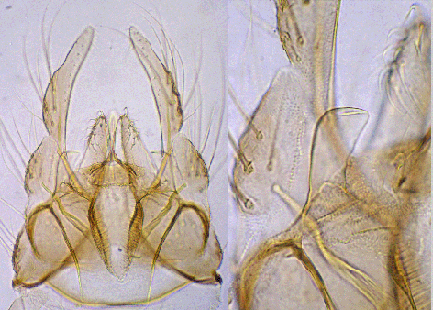Chironomus species PK5
A member of the Chironomus dorsalis group. Conspecific with C. alpestris.
Adult
Male: Wing length 3.60 mm, width, 0.82 mm. VR 1.08. AR 2.96.
Head: Frontal tubercles small, abt 18 µm. 26 clypeal setae.
Palps (microns) 55 ; 53 : 215 : 230 : 275.
Thoracic setae: Acrostichal - at least 9; Dorsolateral - 21 - 22; Prealar 8;
Supra-alar - 1; Scutellar in two rows - anterior 8, posterior 14.
Legs with dark knees, tibia and tarsi; no beard.
Lengths (micron) and proportions :
|
|
Fe
|
Ti
|
Ta1
|
Ta2
|
Ta3
|
|
PI
|
1330
|
1140
|
1860
|
900
|
790
|
|
PII
|
1410
|
1285
|
780
|
420
|
300
|
|
PIII
|
1570
|
1570
|
1050
|
600
|
440
|
|
|
Ta4
|
Ta5
|
LR
|
F/T
|
BR
|
|
PI
|
650
|
280
|
1.63
|
1.17
|
3.2
|
|
PII
|
190
|
145
|
0.65
|
1.10
|
-
|
|
PIII
|
280
|
160
|
0.67
|
1.00
|
-
|

Male terminalia of C. sp.PK5 Note the D-type superior volsella
The superior volsella (above) is a little 'beak-like' (D-type of Strenzke 1959), but beak is quite short; about 5 setae central on tergite 9.
Female - not known.
Larva: A medium plumosus-type. Ventral tubules relatively long, anterior with elbows, posterior pair coiled.
Head capsule relatively long and narrow, mentum relatively narrow, mentum width/VHL about 0.49-0.52. Gular region darkened over posterior two thirds, frontoclypeus dark, also darkened outside V.
Mentum (Fig. a) with 4th laterals reduced to about the level of 5th laterals (type II), 1st laterls tending to curve outwards; centre trifid tooth with c2 teeth well separated (type III).
Ventromental plates (Fig. c) separated by about 0.40 of the mentum width, with about 35 - 37 striae. Pecten epipharyngis with about 12 - 14 teeth.
Premandible with sharp teeth, the outer tooth longer; inner tooth about 1.5 to 2 times wider than outertooth.
Antenna (Fig. d) with basal segment about 3.7 times longer than wide, ring organ about half way up from base; AR about 2 - 2.14, A3 quite short; segment proportions (microns) 123 : 30 : 7 : 11 : 6.
Distance between antennal bases may be greater than or about equal to that between the S4 setae.
Mandible (Fig. b) with 3rd inner tooth well developed but only moderately colored (Type IIIB; about 18-20 furrows on the outer surface at the base.
Cytology: Four polytene chromosomes with the pseudothummi-cytocomplex combination BF, CD, AE, G.
Nucleolus subterminal in arm G, with a large BR about 1/3 from the other end of the arm. No polymorphism in 5 specimens examined.
Arm A1: 1 - 2c, 4 - 9, 2d - 3, 12- 10, 13 - 19 as dorsalis
Arm B1: Puff distal of centre of arm with dark bands distal.
Arm C1: Large puff about the middle of the arm.
Arm D1:
Arm E1: 1 - 2c, 8b - 6, 3 - 2d, 8 - 9, 4 - 5, 12a - 10, 12b - 13 i.e. In5-9 and In9-3 from dorsalis
Arm F1: possibly 1 - 10, 15 - 11, 16 - 23 as halophilus
Found: India - Jammu & Kashmir: Kabeer colony, Jammu; Deoli Village.
Also found in Israel - Mt. Hermon.
DNA Sequence
The mitochondrial DNA sequence indicates that this species is quite close to the European C. alpestris, Goetgh.
[ Return to Index
| Go to References ]
|
